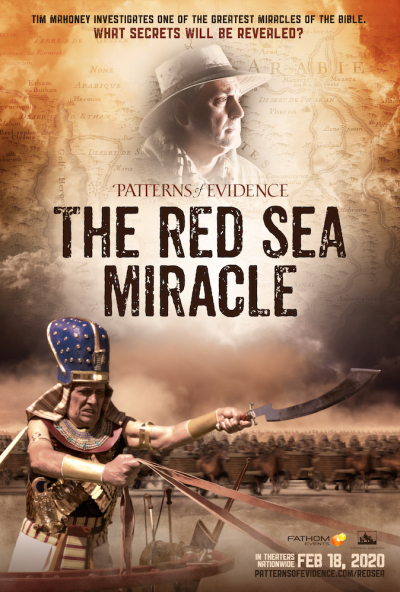New ‘Patterns of Evidence’ film examines biblical miracle: Parting of the Red Sea

“Patterns of Evidence” filmmaker Tim Mahoney is gearing up to release the next installment in his series of archaeological and scientific investigations into historical biblical accounts. His latest film looks at the Exodus miracle of the parting of the Red Sea.
The biblical account of the parting of the Red Sea is found in Exodus 14 and details the Israelites' escape from slavery led by Moses as the Egyptian army pursued them.
Following the success of Mahoney's previous award-winning "Patterns of Evidence" projects, he believes this film, like the others, will refute secular scholars’ claims that the Bible is mere fiction and do so in a way that is understood by people worldwide.
“Patterns of Evidence: The Red Sea Miracle,” a Thinking Man Films production, will be in select theaters nationwide for one day only on Feb. 18 through Fathom Events.
The following is an edited transcript of The Christian Post's interview with Mahoney who has been investigating biblical accounts for over 20 years. In the interview he detailed what it was like to retrace the steps of Moses and the Israelites as he searched for archaeological evidence to create “Patterns of Evidence: The Red Sea Miracle” Part 1 and 2.
The Christian Post: In the film you describe the Egyptian and Hebrew accounts of the parting of the Red Sea. Most Christians visualize the Charlton Heston version of that account, which you said you have also done. Can you explain the two positions?
Mahoney: When we make a “Patterns of Evidence” film we look for a way to explain the different viewpoints that are being used to explain biblical events such as the Red Sea miracle.
In this new film, we identified what we termed an Egyptian Approach which believes that the Exodus account borrowed Egyptian words to describe the crossing location. And they believe these words point to the crossing at one of the reedy lakes near the border of Egypt.
The other viewpoint we call the Hebrew Approach disagrees with a near Egypt location. They believe that the words used to describe the location where Moses and the Israelites crossed are Hebrew words and do not have a connection to Egypt. They also point to other biblical references that place the sea of the Exodus at the Gulf of Aqaba.
CP: In the film you also explain the importance of the Hebrew and Egyptian translations of individual words when discussing the parting of the sea account. How revealing was the actual translation in your research?
Mahoney: What we know is that the sea was first called “Yam Suph" in Hebrew. Centuries later it is translated into Greek as “Red Sea.” Over time people also called the location “Sea of Reeds.” What we would learn is that reeds don’t grow in saltwater, they grow in freshwater. The Egyptian approach believes that the word “Suph” might be a translation from the Egyptian word “Pa Tufy” which means “place of reeds.”
Yet, the Hebrew Approach challenges this connection claiming that Moses was writing an eyewitness account to Hebrews using Hebrew words and Hebrew meanings, not Egyptian.
CP: What were you most surprised to find out about the parting of the sea?
Mahoney: This is the first film of a two-part film event. The Red Sea Miracle part 1 (in theaters on Feb. 18) really lays out two distinctly different ways people see God working in a miracle. The Egyptian Approach sees the parting as a naturalistic event where wind was the agent and it moved water naturally. The miracle would be in the timing.
The Hebrew Approach primarily believes that the miracle was not only caused by wind but that God miraculously parted the water. The depth of the water would not be a problem for the God of the Bible who created the universe.
CP: What would you like for others to take from this new installment of Patterns of Evidence?
Mahoney: We all are faced with difficult times in our lives, when we think we are not going to make it. We are trapped at the sea with the Egyptians behind us. But God wants us to call on Him and trust Him for the solution to our dilemma.
CP: Have your discoveries impacted historians' beliefs about these biblical accounts?
Mahoney: I have learned that many historians don’t change their minds once they declare a position. But I am OK with that. I enjoy hearing what they believe and why they believe it. I couldn’t make these films without them. I do think I have help raise the awareness of these questions about the historical credibility and have shown a pattern of evidence that matches the biblical events. At the end of the day, it’s up to the viewer to decide if these films make sense. But it will give them a lot to think about. That’s why we call our company Thinking Man Films.
CP: What's next for the "Patterns of Evidence" series?
Mahoney: The "Red Sea Miracle" part 2 (in theaters on May 5), that’s when we look closer at the locations for the sea's parting. We will look at how the sea was parted [and] was it naturalistic or supernatural, which depends [on] where you place the crossing.
We will also look to see if claims of chariot wheels on the bottom of the seafloor have any merit.
And finally, we will explore the question of miracles. What is a miracle and do they still happen today?





















